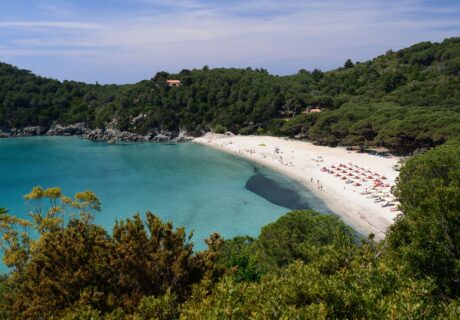Itinerary in the Serchio Valley
4 min · 29 May 2023

Squeezed between the soft reliefs of the Apennines and the rugged ones of the Apuan Alps, the Serchio Valley encapsulates the most intimate and wild soul of Tuscany. It takes its name from the river of the same name that runs through it and includes the Garfagnana, or Upper Serchio Valley, and the Media Valle del Serchio (commonly called Mediavalle).
What to see in the Serchio Valley? Here is an itinerary that starts in Ponte a Moriano and ends in Bagni di Lucca, crossing the Pizzorne Plateau and small villages full of charm and history.
Starting from the narrow passage of Ponte a Moriano, which marks the entrance to the Serchio Valley, the first stop on the itinerary is Matraia, a hamlet in the municipality of Capannori. The Matraia stone, also known in Tuscany as “macigno”, is a medium-fine grained sandstone that has always been used to embellish and finish buildings, squares, churches and historical monuments of Lucca and its territory. Among the places of interest, the Church of San Michele Arcangelo stands out in the lower part of the town. Probably built between the 11th and 13th centuries, it has undergone numerous transformations over time. Inside it preserves two seventeenth-century altars, a wooden sculpture of the Madonna with Child dating back to the fourteenth century and a painting by the Florentine painter Baccio Lomi.
From Matraia you then reach the top of the Pietra Pertusa hill, from which you can enjoy a spectacular panoramic view. In Pietra Pertusa it is also possible to see the remains of an ancient dolmen built by the people who inhabited these lands between the 5th and 3rd millennium BC. For the bravest there is the Suspended in the Green Adventure Park, which offers 14 routes with different levels of difficulty, for all ages and with maximum safety. Walkways, ropes, Tibetan bridges, pulleys and breathtaking jumps of over 200 meters await you. Access to the park is free for those who do not take part in the routes.
The next stop is Boveglio, a hamlet in the municipality of Villa Basilica. It is a small village with ancient origins characterized by stone portals, medieval and Renaissance buildings and narrow paved streets. In the highest part of the town stands the massive Clock Tower, which acts as a sentinel over the town. Instead, a few steps from the Porta Spedale there is an imposing complex of religious buildings consisting of the Church of Santi Jacopo e Ginese, the bell tower and the Oratorio della Misericordia. Inside the church there is a hexagonal baptismal font of Romanesque structure, a marble tabernacle attributed to Matteo Civitali and the organ built by Michelangelo Crudeli in 1777.
A few kilometers from Boveglio is the village of Benabbio, located 479 meters above sea level. In 1581 the famous French philosopher and writer Michel de Montaigne, after visiting it, reported having seen a “beautiful village”. In addition to the ruins of the castle, the Parish Church of Santa Maria Assunta is absolutely worth a visit. Attested for the first time in 1260, it was subjected to a substantial renovation in 1338 and subsequently remodeled over the centuries. The triptych created in 1469 by Baldassarre di Biagio is valuable in the building.
Finally, the last stop on the itinerary is Bagni di Lucca, a town renowned since ancient times for its beneficial thermal waters, which acquired great importance at the beginning of the 19th century, when the town was frequented by poets and writers of Romanticism. Among the things to see we find: the Art Nouveau complex of the Real Casino, inaugurated in 1839; the Chain Bridge, built starting in 1840 based on a design by the well-known architect Lorenzo Nottolini; and the Demidoff Chapel, designed and erected by Giacomo Marracci in 1825 at the behest of the Russian prince Niccolò Demidoff.








